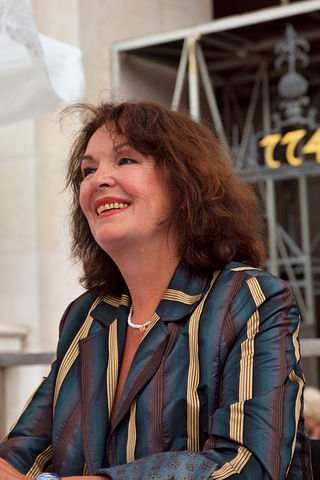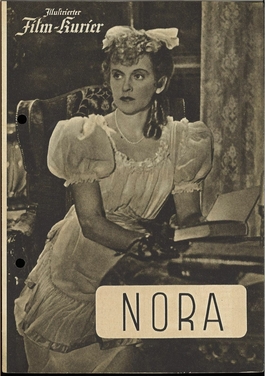
A Doll's House is a three-act play written by Norwegian playwright Henrik Ibsen. It premiered at the Royal Danish Theatre in Copenhagen, Denmark, on 21 December 1879, having been published earlier that month. The play is set in a Norwegian town c. 1879.

Jane Seymour Fonda is an American actress and activist. Recognized as a film icon, Fonda's work spans several genres and over six decades of film and television. She is the recipient of numerous accolades, including two Academy Awards, two British Academy Film Awards, seven Golden Globe Awards, a Primetime Emmy Award, the AFI Life Achievement Award, the Honorary Palme d'Or, and the Cecil B. DeMille Award.

Accident is a 1967 British drama film directed by Joseph Losey. Written by Harold Pinter, it is an adaptation of the 1965 novel Accident by Nicholas Mosley. It is the third of four Losey–Pinter collaborations; the others being The Servant (1963), Modesty Blaise (1966) and The Go-Between (1971). At the 1967 Cannes Film Festival, Accident won the Grand Prix Spécial du Jury award. It also won the Grand Prix of the Belgian Film Critics Association.

Jenny Julia Eleanor Marx, sometimes called Eleanor Aveling and known to her family as Tussy, was the English-born youngest daughter of Karl Marx. She was herself a socialist activist who sometimes worked as a literary translator. In March 1898, after discovering that her partner Edward Aveling had secretly married the previous year, she poisoned herself at the age of 43.

Delphine Claire Beltiane Seyrig was a Lebanese-born French actress and film director. She came to prominence in Alain Resnais's 1961 film Last Year at Marienbad, and later acted in films by Chantal Akerman, Luis Buñuel, Marguerite Duras, Ulrike Ottinger, Francois Truffaut, and Fred Zinneman. She directed three films, including Sois belle et tais-toi (1981).

Sara is a 1993 motion picture directed by Dariush Mehrjui. The film is based on Henrik Ibsen's 1879 play A Doll's House, with Sara in the role of Nora, Hessam in the role of Torvald, Sima in the role of Ms Linde and Goshtasb in the role of Nils Krogstad.

A Doll's Life was a 1982 musical with music by Larry Grossman, and a book and lyrics by Betty Comden and Adolph Green. A sequel to the 1879 Henrik Ibsen play A Doll's House, it told the story of what happened to the lead character, Nora, after she left her husband and her old life behind to face the world on her own; in doing so, it examined several aspects of feminism and the ways in which women are treated.
A Doll's House is an American drama television film that premiered on NBC on November 15, 1959, as part of the Hallmark Hall of Fame anthology series. It is directed and produced by George Schaefer, from a teleplay by James Costigan, based on Henrik Ibsen's classic play of the same name. The film stars Julie Harris and Christopher Plummer, who previously co-starred in Little Moon of Alban.

A Doll's House is a 1973 British film, directed by Patrick Garland. It is based on Henrik Ibsen's play A Doll's House (1879).
A Doll's House is a 1992 videotaped television production of the 1879 play of the same name by Henrik Ibsen. It was directed by David Thacker and first broadcast on BBC 2 on 21 November 1992, and was later shown on PBS's Masterpiece Theatre in the United States.

A Doll's House is a 1917 American silent drama film based on the eponymous 1879 play by Henrik Ibsen. The film was written and directed by Joe De Grasse, and stars Lon Chaney, William Stowell and Dorothy Phillips. Film historian Jon C. Mirsalis stated that director De Grasse's wife Ida May Park wrote the screenplay, but most sources attribute both the writing and directing of the film to De Grasse himself. The film is today considered lost.

The Hole in the Wall Theatre was a small theatre in the Perth suburb of Leederville, Western Australia, operating from 1968 to 1984. In 1984 it was relocated to a civic auditorium in Subiaco which, as of 2020, is known as the Subiaco Arts Centre, a heritage-listed building, managed by the Perth Theatre Trust.

Elisabeth Trissenaar was an Austrian actress.

Nora is a theatre show directed by Haris Pasovic and produced by the East West Theatre Company based in Sarajevo, Bosnia and Herzegovina. The show is based on Henrik Ibsen's 1879 play A Doll's House, which was translated into Bosnian by Munib Delalic. Nora is the story of a young successful couple who seemingly live a perfect life but suffer from marital problems under the surface.

A Doll's House is a 1922 American silent drama film produced by and starring Alla Nazimova and directed by her husband Charles Bryant. The couple released the film through United Artists. It is based on the 1879 play A Doll's House by Henrik Ibsen with the scenario written by Nazimova under the pseudonym Peter M. Winters. The film was the fourth silent version filmed of the play, being preceded by a 1918 Paramount film directed by Maurice Tourneur. The film is classified as being lost.

The Young Lovers is a 1964 black-and-white American romantic drama film. It was released by Metro-Goldwyn-Mayer in November 1964. The sole directorial effort of its producer, Samuel Goldwyn Jr., it stars Peter Fonda and Sharon Hugueny, with second leads Nick Adams and Deborah Walley. Scripted by George Garrett from a 1955 novel by Julian Halevy, the film was shot in September–October 1963 and released a year later.

Nora is a 1944 German drama film directed by Harald Braun and starring Luise Ullrich, Viktor Staal and Franziska Kinz. The film is an adaptation of Henrik Ibsen's play A Doll's House. The film uses Ibsen's alternate ending where the unhappy couple are reconciled at the end. Location shooting took place around Park Glienicke in Berlin and along the North Sea coast, particularly around Husum. The sets were designed by art directors Emil Hasler and Walter Kutz.
A Doll's House, Part 2 is a 2017 play written by Lucas Hnath. The play premiered at the South Coast Repertory, in April 2017, before transferring to Broadway at the John Golden Theatre. The play "picks up after Henrik Ibsen's 1879 play A Doll's House concludes".
Laura Kieler was a Norwegian-Danish novelist. Events from her life and marriage served as the inspiration for the character Nora Helmer in Henrik Ibsen's play A Doll's House.

"What Happens After Nora Leaves Home?" is a speech given by Chinese writer Lu Xun at Beijing Women's Normal College in 1923. In his speech, Lu Xun evaluated the ending of A Doll's House by Norwegian playwright Henrik Ibsen, where the heroine Nora leaves home to search for her selfhood. Concerned with the blind following of Nora's rebel, Lu Xun spoke to address its potential danger.
















